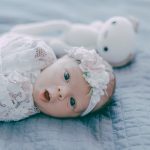Choosing the right clothing for infants is one of the most important and exciting parts of preparing for a baby. From soft bodysuits to cozy sleepers, infant clothes must balance comfort, safety, practicality, and even a touch of style. Whether you’re a new parent, a relative, or a gift-giver, understanding what to look for in baby clothing can make a big difference in both the baby’s well-being and your convenience.
1. Comfort is Key
Babies have delicate skin that can easily become irritated. For this reason, comfort should always come first when selecting infant clothes. Natural fabrics like 100% cotton or organic cotton are breathable, gentle, and hypoallergenic, making them ideal for a newborn’s sensitive skin. Soft seams, tagless labels, and stretchy materials ensure that the baby is comfortable throughout the day and night.
It’s also essential to choose clothing that allows free movement. Babies are constantly growing, kicking, and wriggling. Clothes that are too tight can be uncomfortable and even restrict movement, while clothes that are too loose might pose safety hazards.
2. Safety Considerations
When it comes to infant clothing, safety should never be compromised. Avoid garments with small buttons, bows, or decorative elements that could become choking hazards. Drawstrings should also be avoided, especially around the neck area.
Additionally, make sure zippers are covered or lined so they don’t scratch or pinch the baby’s skin. Snap fasteners are often preferred, especially in bodysuits and sleepwear, as they are easier to use and safer for infants.
Look for clothes labeled as flame-resistant or snug-fitting for sleepwear, especially in regions with strict safety standards. These guidelines are in place to protect babies from potential fire hazards while sleeping.
3. Ease of Dressing and Diapering
Changing diapers is a frequent task for any parent or caregiver, so convenience is crucial. Clothes with snap buttons along the legs, envelope necks, or zip-up front closures can make dressing and undressing easier. One-piece outfits like rompers or zip-up sleepers are a favorite for nighttime because they reduce the number of clothing layers.
During the first few months, newborns may need multiple clothing changes a day due to spit-ups, diaper leaks, or drool. Having practical, easy-to-remove clothing will save time and make cleanup less stressful.
4. Seasonal and Climate-Appropriate Choices
Infant clothing should match the climate and season. In colder months, layering is important. Start with a breathable onesie and add pants, a long-sleeve shirt, socks, and a warm hat. In warmer months, lightweight and breathable materials keep the baby cool and prevent overheating. UV-protective clothing and wide-brimmed hats are also recommended for sunny outings.
5. Style and Personal Expression
While functionality is critical, many parents also enjoy dressing their babies in cute, stylish outfits. Today’s infant clothing market offers a wide range of colors, patterns, and themes — from minimalist and neutral designs to fun animal prints, holiday outfits, and personalized name embroidery.
Conclusion
Infant clothing is about more than just adorable designs — it plays a key role in keeping your baby comfortable, safe, and happy. By focusing on soft fabrics, secure designs, and practical features, you’ll be better equipped to dress your little one for both everyday adventures and special occasions. Always remember: a happy baby starts with comfortable clothes.






